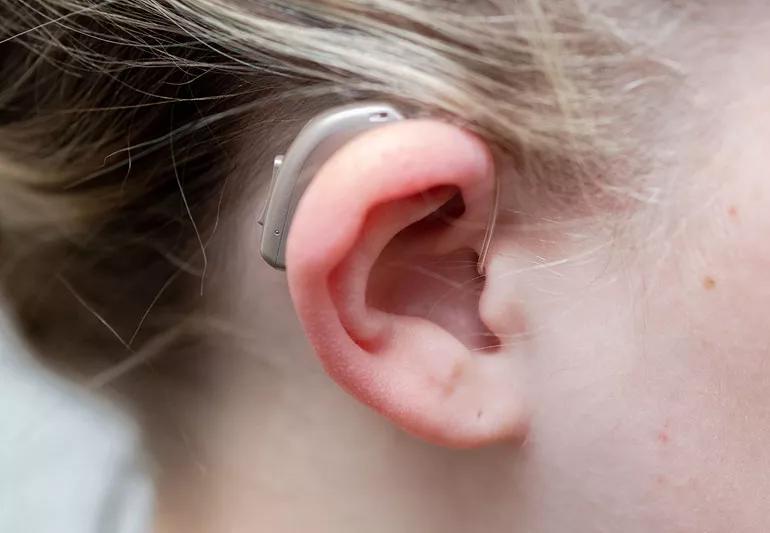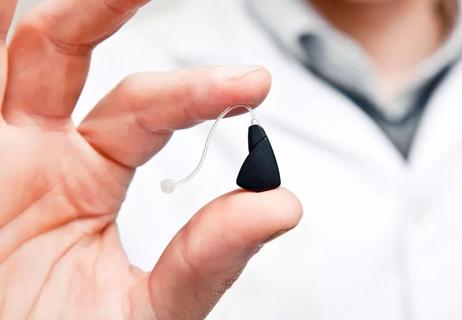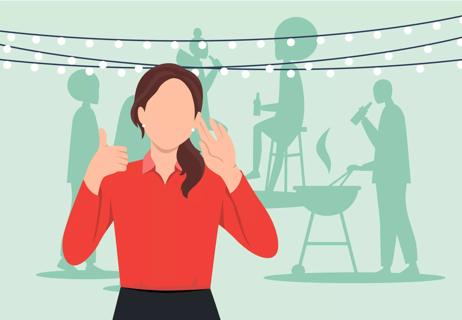Hearing aid technology has vastly improved over the last several years

The human ear is a powerful tool. It can pick up the steady thrum of a refrigerator a few rooms away or the slight snap of a twig while you’re walking in the middle of the woods. It can even help you home in on a single voice while isolating the background noise of a large crowd, busy street or booming concert. But if you’re experiencing hearing loss, isolating certain sounds and focusing in on the right pitches may become increasingly difficult, especially as we age.
Advertisement
Cleveland Clinic is a non-profit academic medical center. Advertising on our site helps support our mission. We do not endorse non-Cleveland Clinic products or services. Policy
Hearing loss is a common phenomenon that can happen as a result of many situations. You can experience hearing loss as you get older or from noise-induced trauma caused by prolonged exposure to loud noises like jackhammers or because of one-off experiences like gunshots or explosions.
If you’ve experienced hearing loss, you may have considered wearing hearing aids to improve your everyday experience. Or maybe you’re still on the fence, not quite sure if hearing aids are right for you. But did you know that the technology behind hearing aids has vastly improved over the last several years, even offering Bluetooth® connectivity?
Whether you just got your first set of hearing aids or you’re still curious, audiologist Katie Hahn, AuD, explains the ins and outs of what you need to know about hearing aid technology and provides tips to help first timers get used to their hearing aids faster.
The process for picking hearing aids begins with a hearing test. If hearing aids are recommended, your audiologist will help you determine the kind of hearing aid you want and which specifications and programming will work best for your lifestyle. You’ll then come in for a fitting where the audiologist will program your hearing aids to your liking and send you home with your new equipment.
Advertisement
There are roughly two kinds of fits for hearing aids:
When you’re placing hearing aids into your ear, you can gently pull down on your ear lobe and back to help open and straighten out your ear canal, which has a slight curve to it, to ease this process.
If you have behind-the-ear or receiver-in-the-ear hearing aids, it comes down to personal preference: You can put the inner-ear portion in first and flip the other component over your ear or do it the opposite way.
“It’s a preference thing and it comes down to what works well for you,” says Dr. Hahn. “You should work directly with your audiologist to practice inserting and removing your hearing aids until you’re comfortable doing so to make sure they’re worn properly. If they’re not inserted properly, it can have a negative impact on the performance of your hearing aids.”
During your fitting, your audiologist will program your device specific to your hearing loss and adjust the volume accordingly. Most hearing aids have buttons on the outside that you can push to control the volume level as you find yourself in different situations.
Fortunately, a lot of hearing aids now have additional Bluetooth controls that allow you to connect your hearing aids to an app on your phone where you can discreetly adjust the volume.
“A lot of people like using their phone as a remote control because it can be hard to find those little buttons on the ears,” notes Dr. Hahn. “If they want to adjust the volume in a group situation and don’t want people to know they’re adjusting their hearing aids, it’s a nice feature to have.”
It can take some time to get used to your hearing aids, especially when you’ve been used to hearing things a certain way for so long. Here are some tips to smooth your transition:
Don’t wait until your next group gathering or social outing to pop your hearing aids in. Instead, you’ll want to wear them at home right away — from the time you wake up in the morning until you go to bed at night, take a shower, go swimming or get your hair done.
“The more sound you hear in your environment, the better your brain will adapt to it,” explains Dr. Hahn. “Even if it’s just sounds at home, like the humming of your refrigerator or the doorbell, or the ding of your microwave — your brain is starting to adjust to those sounds.”
Advertisement
If you wait to wear them until you go out to a restaurant, concert or friendly get together, your brain might be overwhelmed by all the external noise. Wearing your hearing aids in your day-to-day, quieter environments will help build up your tolerance to everyday sounds and allow your brain to adjust to wearing hearing aids.
It used to be common for older hearing aids to produce some feedback, but that shouldn’t be the case now. The feedback management systems in today’s hearing aids have vastly improved, so if you’re experiencing feedback, you should speak to your audiologist.
“Your audiologist will make sure the fit is appropriate, that there’s no wax in your ears and make sure the volume is set at an appropriate level so there isn’t any feedback,” says Dr. Hahn.
You don’t have to get used to your hearing aids all on your own. Your family and friends can help by doing several things that include:
“When people are talking really fast, it’s going to be harder for you to process that information, especially if there’s a hearing loss,” says Dr. Hahn.
“People are often afraid that they’re going to be overwhelmed by all of the sound and it’s going to be difficult for them in group situations, but the reality is, if you’re wearing hearing aids, it should make it easier for you in those group environments,” says Dr. Hahn.
Advertisement
“There is a maximum output level and it’s based on the programming we’re doing. So, hearing aids are trying to adjust for you in noisy situations to cut down on some of that background noise and help focus in on speech information.”
By testing out your hearing aids in social settings, you can determine what kinds of adjustments need to be made to your programming to make those experiences easier for you. But don’t feel like you have to rush into it: The more time you spend wearing your hearing aids at home, the more your brain will become equipped to hearing noises outside of your home.
“We want people to remain connected and that’s a huge reason why people are fit with hearing aids,” says Dr. Hahn. “You want to experience as many environments as you can.”
Visual cues help your brain process the sounds it’s receiving — that’s why it helps to speak to someone face-to-face rather than from another room or when they’re turned away from you. The same idea applies to when you’re watching TV or listening to an audiobook.
“Being able to read along while you’re hearing something helps fill in the blanks,” says Dr. Hahn. “The hearing system is very complex. So, if you can read along and hear it at the same time, you’re making that connection between what you hear and what you see.”
Advertisement
In some cases, you can connect your phone directly to your hearing aids using Bluetooth. This ensures your phone calls remain private and provides you with the most direct sound available. But if your hearing aids aren’t Bluetooth compatible, you should try taking phone calls using the speaker phone option — this way, you can maximize the amount of sound you hear by using both of your ears and you don’t have to worry about awkward placement of the phone over your hearing aid.
As you wear your hearing aids, you’ll find yourself in new and exciting experiences. Sometimes, problems will arise, but when is a problem important enough to make an appointment with your audiologist, and when is it just an issue that will get better over time? Dr. Hahn says you should follow up with your audiologist for any of the following:
“Take notes and let your audiologist know what’s working well and what isn’t so we can make better programming adjustments,” says Dr. Hahn.
Regardless of the cause of hearing loss, there are strong misconceptions and fear associated with wearing hearing aids. Some worry that wearing a hearing aid means they’re impaired or worry it’s a sign of old age. Others may worry that a hearing aid will cause their ears to become dependent on the device and, therefore, cause their hearing to decline further when they don’t use them. But Dr. Hahn assures these fears can be laid to rest.
“Progression of hearing loss will happen no matter what, and it’s typically due to aging, genetics, family history or noise exposure,” she explains. “Wearing hearing aids is really just an assistive tool that is designed to help with the hearing loss you have.”
And hearing loss presents itself in a variety of ways. Maybe everything is starting to sound a bit more muffled than it used to. Or maybe you’re having a hard time focusing on a single person’s voice as they’re speaking to you in a group setting. Because each personal experience of hearing loss is different, there’s no one-size-fits-all hearing aid. Each hearing aid is designed with different fits, different programming and different auditory options to improve your relationship with hearing.
“There are so many variables that come into play that I always tell people it’s a really personal experience,” says Dr. Hahn. “If you have any concerns about your hearing loss, I think you need to try hearing aids and see what they can do for you.”
Learn more about our editorial process.
Advertisement

Seeing a licensed professional is still key to treating hearing loss

Four steps to getting the perfect hearing aids for your lifestyle

There are lots of tips, tricks and assistive devices out there that can help

Most recommended precautions center around minimizing bruising or swelling

Even one drink can have an impact on your cognitive function leading to slurred speech, blurred vision and impaired memory

Understand who may (and may not) benefit

Type 2 diabetes isn’t inevitable with these dietary changes

Applying a hot or cold compress can help with pain